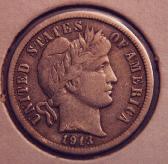
|
RECOVERY TECHNIQUE

This picture was taken in MY yard, normally I wouldn't make such a mess!!
Read the information below to see how to do a good job.
Some people think you take your machine out, swing it around awhile, then dig a hole. Well, I guess basically that is what you do, but there is more to it. The recovery of your find is very important, you must be precise in pinpointing or you may damage that valuable piece of Americana that you've discovered.
If the lawn is well kept you may not wish to dig a hole unless it is absolutely necessary. I use a small 1/8 inch diameter brass probe that is about 8 inches long. The tip is rounded so that if I should touch the buried object, I will not scratch it. Slowly and carefully insert the probe into the ground where you believe the object is. Do this repeatedly until you "touch" something solid. Check the depth that the probe has been inserted into the ground, if it is shallow, you can use the probe itself to pry the object to the surface. If the object is 3 inches or more down, then you will have to dig a hole to recover it.
Once pinpointed, move out away from the immediate area approximately 3 inches. Using your digging tool, plunge down into the dirt the whole length of the tool. Then procede to cut the sod around the target in a circle, until you have completely cut about 2/3 of distance around it, then stop. This will leave a section of sod that is not cut. This uncut section will prevent the sod from drying out completely because the root system will not be damaged. Gently pull the "flap" of sod back to expose the ground beneath it. Use your detector to pinpoint again to determine if the target is in the hole or in the flap of sod.
If the target is in the sod, carefully remove small quantities of soil with your hand and waive it over your search coil. (Please remember to take off all rings, watches and metallic objects before you do this!!) If the target is in the handfull of dirt, you have just made your recovery!! Then re-check the area with your detector for more targets. I have found as many as 9 coins in one hole! I cannot count the number of times I've recovered more than one coin or object in the same hole. I guess the best multiple recovery I've made has been 2 Indian Head cents down at about 8 inches. A close second would be 4 wheat cents, dating in the 40's and 50's, and a silver Roosevelt dime.
If the target was still in the hole, carefully remove some of the loose dirt remaining
 in the hole with your hand. Some people prefer to use gloves for this because of the risk of glass or sharp objects protruding from the sides of the hole. Waive this material over your search coil. If you still haven't found the target, use your digging tool to carefully loosen up more of the soil from the sides and bottom of the hole. Repeat this process until you have made your recovery. Notice that I've underlined carefully each time in this section? The photo on the right will explain why. Notice just under the neck on this otherwise very-fine Barber dime, there is a hefty scratch across the neck and the 13 in the date. I was impatient and dug in a hurry when I was using my digging tool to loosen up the dirt in the hole!
in the hole with your hand. Some people prefer to use gloves for this because of the risk of glass or sharp objects protruding from the sides of the hole. Waive this material over your search coil. If you still haven't found the target, use your digging tool to carefully loosen up more of the soil from the sides and bottom of the hole. Repeat this process until you have made your recovery. Notice that I've underlined carefully each time in this section? The photo on the right will explain why. Notice just under the neck on this otherwise very-fine Barber dime, there is a hefty scratch across the neck and the 13 in the date. I was impatient and dug in a hurry when I was using my digging tool to loosen up the dirt in the hole!
Nothing look worse than a bunch of loose dirt lying around a recently dug hole. Consider using a rag, frisbee or something to contain the excavated material you remove from the hole. Each handfull of dirt taken from the hole should be placed on the "drop cloth" so that after the recovery is made you can simply dump the contents back into the hole. This is a nice tidy way of filling in the small crater you've made.
Now take the small flap of sod and replace it. take the time to gently knead in the surrounding sod to close up any gaps in the soil. Step on the flap with the heel of your shoe to make sure its in place, then brush the top of the sod with your hand to make the grass blend back together. With practice you will not be able to see where you've dug the hole and will keep the owners of the property happy!
There are a lot of different recovery methods, but I've given the examples of what works best for me. Other detectorists will disagree with my methods but there are some good suggestions here. Use these methods if you wish or dream up some of your own but most of all remember to:
DO A NEAT JOB!
TAKE YOUR TRASH WITH YOU!
Don't give someone an excuse to ban the use of metal detectors in your area.